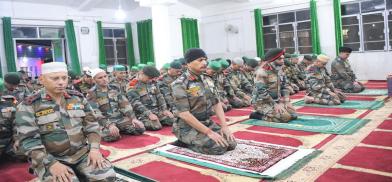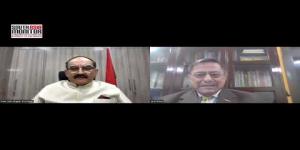Men who fight together must pray together: The hallowed tradition of secularism in India's armed forces
As officers in the armed forces, their religion is that of their soldiers, sailors and airmen and all religious festivals of India are attended and taken part by all officers and families, writes Col Anil Bhat (retd) for South Asia Monitor

Bravery and patriotism apart, secularism is an article of faith in the Indian armed forces. In all three India-Pakistan wars of 1947¸1965 and 1971, the Pakistan Army personnel felt most frustrated about Muslims in the Indian Army, all of who displayed outstanding valour and many of who won gallantry awards.
In the Army, peace stations house temples, gurudwaras, masjids and churches in a barrack or parts of different barracks. In field conditions, these religious spaces may be in a tent or even in a bunker. While on the move, there is always one 3-ton sized truck in which all religious books and other material are carried to set up a field praying space.
Most North Indian communities-based regiments/battalions have a temple and gurudwara. Groups like Madras Regiment and Madras Sappers have a temple, a church and a mosque, with a combatant religious teacher each, referred to as pandit, granthi, priest and maulvi.
There is also a joint praying space which is created in military units of the all-in-one Sarva Dharma Sthal -- meaning a shrine for all faiths.
There is an interesting incident and not without humour about how a commanding officer (CO) detailed a South Indian Christian officer to perform the duties of the unit’s Hindu religious teacher or panditji for a religious ceremony and that too at short notice. In the late evening at the officers’ mess, a message came about the panditji being unwell. This meant that some suitable soldier must officiate as the anditji for the next morning’s ‘Mandir Parade’, as it is known. Promptly, the CO ordered the officer to take over the duties of the panditji.
The assigned officer treated himself to some black coffee to neutralize the effect of some whisky he had consumed, did some ‘revision’ of the subject and functioned quite smoothly as the panditji the following morning. The linguistic ‘alterations’ in the South Indian officer’s delivery caused some unavoidable laughter which was suppressed but it endeared that officer all the more to all ranks.
An old tradition which has flourished pre- and post-Independence in Indian Armed Forces is all ranks celebrating Hindu-Sikh, Muslim and Christian religious festivals together, praying together and partaking ‘prashad’ (food blessed by gods) together, validating the tradition of ‘my religion is my soldiers’ religion’. All religious festivals are happily celebrated together. Men who fight together must pray together.
Lt Gen Syed Ata Hasnain writing in the Times of India on October 12, 2016 stated: “In preventing Nawazuddin Siddiqui from acting in a Ramlila in Muzaffarnagar, the Shiv Sena’s local leader probably thought he would score some popularity. The exact opposite occurred. To a short tweet put out by me recounting the fact that as Muslims, both my spouse and I, invariably led the puja of our army unit in its temple every other Sunday, I received over 10,000 responses welcoming our action, suggesting that the country stands essentially secular, with people who supported my tweet being from all faiths and all walks of life and representing a fairly good sample of India.”
Not many Indians know how faith is handled within the armed forces, the one institution where Indian secularism is feted and followed meaningfully, something worth emulating by our people, even if it sounds a pipe dream.
Faith is extremely important for soldiers. In a profession where life hangs by a thread, people tend to repose greater trust in God than almost any other profession. Troops being launched into major operations pray before they start. Families of servicemen have to repose even greater trust in religion and connect with God as the breadwinner’s life is at stake.
There is an implicit convention that the faith of the troops becomes the faith of the officer. He may follow any belief at home but with troops and in field areas the unit’s faith is his faith. In peace stations, the spouse follows her husband as a part of the bonding exercise so important in the profession.
Not only religion but even caste is overlooked for competence. Read this wonderful episode in this writer’s Regiment, 4 HORSE (also known as Hodson’s Horse).
Young Tirath joined the Regiment, in which his grandfather had served, as a safai tradesman (cleaner), and was incidentally of the lowest Hindu caste. He was detailed for the Officers’ Mess and began making himself very useful. Amongst the Mess staff of soldier cooks, mess waiters and others, there was one elderly non-combatant cook who had earlier worked for Maharaja of Kapurthala.
Known as Baba, he was a wizard of a chef with both Indian and continental recipes. Tirath, who had been watching Baba’s cooking processes, urged Baba to consider teaching him. Baba agreed and Tirath achieved the expertise to cook some tasty dishes. The Regiment then applied for a change of trade for Tirath -- from cleaning staff to cook.
We had the pleasure of exotic dishes and desserts baked in field conditions in a ghee-tin known widely as the ‘peepa’. Tirath rose to the rank of Daffadar (Cavalry equivalent of Havildar-3 Shevron stripes) Cook. Since he retired, he is a much sought after caterer.
In the decades since independence, there have been many inter-religion marriages among Indian armed forces personnel, particularly officers, which is again a great example for the nation, where the horror of honour killings for inter-caste and inter-religious marriages continues.
As officers in the armed forces, their religion is that of their soldiers, sailors and airmen and all religious festivals of India are attended and taken part by all officers and families. In field/forward areas, festivals are celebrated keeping in view the operational commitments.
Let us not forget that during the 1971 India-Pakistan War, the Indian Army’s top leadership was an interesting mix. General (later Field Marshal) S.H.F.J. Manekshaw was a Parsi, Lt Gen J.S. Aurora, the Eastern Army Commander, a Sikh, and Maj Gen (later Lt Gen) J.F.R. Jacob was Jewish.
So, when photographs of an Iftar gathering was recently posted from the ‘PRO Defence Jammu’ handle with the caption “Keeping alive the traditions of secularism, an Iftar was organised by the Indian Army at Arnora in Doda district. #Ramadan”, it was just tradition being kept alive.
Unfortunately, a troll was reportedly put out by Sudarshan TV editor-in-chief Suresh Chavhanke said: “Ab yeh bimaari Bharatiya Sena mein bhi ghus gayi hai? Dukhad.” (Now this illness has entered the Indian Army as well? Sad.)
Considering that the troller is an 'editor', this reflects his own ignorance and chauvinistic religious bias of what is a very old tradition in India’s armed forces. He and his ilk have contributed much towards the negative projection of Hinduism which has always stood out for its tolerance and respect for all faiths.
The Army need not have removed the tweet.
(The author is a former spokesperson of Defence Ministry and Indian Army. Views are personal. He can be contacted at wordsword02@gmail.com)
<a href="https://hotbotvpn.page.link/?link=https://africanpussypics.com/">African pussy images</a> is fire — mature ladies and teens bounce on hard, slurp thick dicks, and flood the sheets with explosion. It's nasty, raw, and free as hell.










Post a Comment